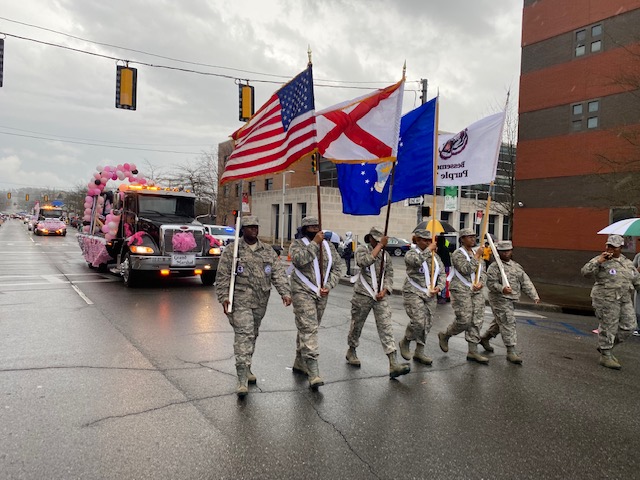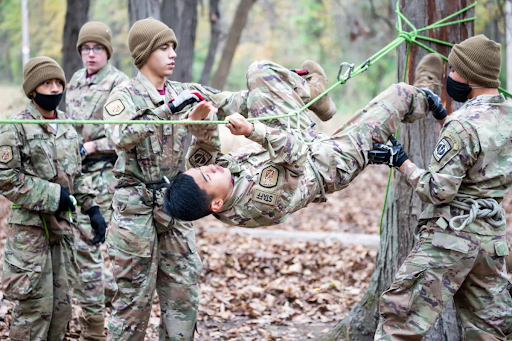- Home
- Air Force JROTC
- Cadet Leadership
- History
- News
- Photos/Videos
- Scholarships
- Special Teams
- Stem Links
- ROTC
- Service Academies
The JROTC, or Junior Reserve Officer Training Corps, is a federal program with origins in the National Defense Act of 1916. The primary purpose of the program was, and is, to develop characteristics and skills in cadets and students, that will help to enrich their future. Indeed, the primary mission of the JROTC program was once described as a way to motivate young men into becoming better members of society.
As such, the program attempts to instill moral characteristics and professional talents into cadets. Often, cadets enrolled into a JROTC curriculum will receive opportunities and experiences unrivaled by other organizations and high schools. Through military-related values, the program creates constructive classroom sessions and activities that help to prepare cadets for the future.
Where Did JROTC Begin? Though JROTC actually began its history with a program in 1911, the JROTC program as we know it today began as a result of the National Defense Act of 1916. When this legislation passed, it meant that military training resources could unite together under one federal umbrella allowing colleges, high schools, and other education facilities to obtain supply funding and military-trained instructors from an ROTC organization.
The U.S. Code, Title 10, Section 2031, defines how such programs are available to provide students with a minimum of three years of military instruction, alongside funded access to academic materials, uniforms, and instructors with experience serving in the U.S. Armed Forces. The purpose of this access to military-inspired training was to provide students in secondary education throughout the United States with crucial social values – such as discipline, leadership, citizenship, and personal responsibility. In 1964, the Vitalization Act allowed for the concept of JROTC, and all that it stood for to expand into other areas, and services, meaning that retired armed forces members could begin teaching young cadets. Since then, numbers provided by the U.S. Army have surged over the years, with ROTC enrollment increasing by 50% between 2006 and 2012.
The History of the JROTC Curriculum Since the very beginning of JROTC, the curriculum for learning has centered on encouraging cadets to participate in activities and studies that get them accustomed to a certain way of thinking and behaving. The curriculum leans on pillars of learner-centered, performance-based education, which links to national instructional leadership resource standards.
During their education, cadets may participate in classes that examine their skills of leaderships, geography, civics, health, global awareness, life skills, and U.S. history. Every lesson they take actively engages students into higher skill performance, and tests their problem-solving skills. Courses will generally cover some military-related subjects, ranging from those covering physical fitness, personal hygiene, and first aid, to lessons on drill instruction and self-discipline. The aim is to provide an environment that nourishes leadership skills and emphasizes core values and abilities that will prove useful throughout the cadet’s life. Students will engage in purposeful, meaningful lessons that lead them to demonstrate success through various accomplishments.

History of AL-934
Color Guard Team

Drill Team

Kitty Hawk Honor Society
CDR (USN) David McCampbell Chapter

1. GENERAL. The Kitty Hawk Honor Society (KHHS) is a national AFJROTC academic honor society that recognizes academic and military achievement by cadets, provides additional leadership/educational opportunities, and encourages excellence. Members of KHHS, once inducted, will wear the KHHS badge on the uniform. KHHS members are also authorized to wear the light blue KHHS shoulder cord, except as specified in paragraph D(2) below.
2. REQUIREMENTS.
A. To qualify for the KHHS one must attain academic excellence in AFJROTC and in overall academic studies, exhibit good character traits, and be willing to accept responsibility. Specific requirements are as follows:
(1) Achieve a 90 average in AFJROTC during the previous academic quarter with no unexcused missed uniform wear.
(2) Have an overall average of 80 for all classes with no failing grade in any class during the previous academic quarter.
(3) Have no out of school suspension for the current academic quarter.
B. Qualified cadets are invited to participate in a “pledge” program to demonstrate their commitment to excellence. Cadets who are selected for the KHHS and successfully complete the pledge program will be inducted at an appropriate ceremony, where they will receive the membership badge and shoulder cord.
C. The KHHS may be called upon to participate in various extracurricular activities. Cadets are expected to attend meetings, actively participate in designated projects, and contribute positively to the KHHS and AFJROTC.
D. To remain in KHHS, cadets must meet the requirements in paragraph 2A and have no more than one unexcused missed meeting during the quarter.
(1) Members who fail to maintain standards during an academic quarter will be placed on probation with no privileges lost.
(2) Members who fail to maintain standards for a second consecutive quarter will remain on probation for the remainder of the school year, lose their voting privilege, and not be permitted to wear the KHHS shoulder cord.
(3) When standards have again been met, the cadet will be reinstated to full membership in the KHHS.
(4) Members who fail to meet standards by the end of the school year will be dropped from the KHHS rolls.
3. OPERATION.
A. The KHHS membership will elect the commander and all other officers (see KHHS by-laws) for the coming school year at the final meeting of the spring semester. All officers must be approved by the SASI. KHAS officers will assume no special rank as a result of their positions in KHAS, but will hold the rank they have in the Cadet Group.
B. The KHHS will meet at least once per month. A copy of the minutes will be filed in the KHHS continuity folder and a copy will be submitted to the SASI within two school days after the meeting. Include the names of members attending in the minutes.
C. The KHHS will conduct at least one community service project, approved by the SASI, each quarter. Projects requiring cadet time and energy and which bring visibility to AFJROTC are preferable to those which only raise money. Presentation Color Guard does not count for the KHHS semester service project.
D. KHHS projects will be fully documented by an after-actions report describing the project, which KHHS members attended/participated, and the results or outcome of the project. Photographs should also be included.
E. All money collected by KHHS will be turned in to the ASI for deposit in appropriate AFJROTC accounts for use as KHHS operating funds or for distribution to designated charitable groups.
Documents
The Raider Team

The UAV Team

ROTC OPPORTUNITIES
WELCOME TO THE PURPLE TIGERS!!
Dear Cadets and Parents/Guardians,
The first thing you should know about Air Force Junior ROTC is that it is more than just another class. Cadets are expected to work to develop themselves as excellent leaders, scholars, and citizens of character that are dedicated to serving their communities. The cadets who strive for success will find many opportunities not available to other students at Bessemer City High School. Whether the cadets decide to go on to college, join our workforce, or serve in our military, AFJROTC cadets are better prepared to succeed and excel in any endeavor.
We have high, yet attainable standards. Due to the nature of the AFJROTC mission, as well as its visibility within the school and the community, it is important to understand that AFJROTC requires its members to adhere to higher academic and behavior standards than might normally be found among the rest of the student body.
Participation in Air Force Junior ROTC is a privilege. Cadets who apply themselves to the academic program and mandatory participatory activities; wear the uniform properly each week; and demonstrate the qualities of a lady or gentleman, should have no difficulty becoming leaders in our program.
AFJROTC is a cadet led, cadet run, immersive program. Cadets have the opportunity to achieve various leadership positions and practice that leadership in real world settings every single day. As such, the emphasis in AFJROTC will be on developing leadership, followership, teamwork, poise, and self confidence. AFJROTC strives to develop young adults who are independently responsible with high levels of personal honor, self-discipline, initiative, attention to detail, and concern for others and their community. Our curriculum and grading policies support these objectives.
AFJROTC is also a STEM program, with courses ranging from topics such as global and culture awareness, space exploration and space operations, or the science and principles of flight. Every week, Cadets will participate in rocketry, robotics, drone flying and/or other STEM related activities. They will participate in at least four STEM related and Community Service related field trips each school year. In addition, those that truly excel will have the opportunity to qualify for flight training (earn their private pilots license), earn their FAA license in Unmanned Aerial Vehicle (UAV) operation, and receive a NOCTI certification in Leadership that is worth college credit.
Whether new or returning, Cadets always begin the school year by receiving a thorough review (in class) of the guidelines and expectations of the Bessemer City High School AFJROTC course. These are spelled out and also available to parents/guardians through the Cadet Guide. Each cadet will receive their own copy of the Cadet Guide once the review has been accomplished. Parents and Cadets can always view or obtain a copy of the latest Cadet Guide through the documents link on this webpage.
Cadets will successfully complete this class by putting forth the necessary effort. Any cadet who needs help can see his/her instructor before, during, or after school. Additionally, Cadets and parents/guardians can stay abreast of current course requirements, activities and schedule by viewing the posted calendar, or reviewing the posted syllabus (located under the Documents Tab).
MSgt Walker and I look forward to working with each cadet and helping to develop the future leaders and citizens of this great nation of ours! Thank you for entrusting us with this responsibility...we do not take it lightly.
- Lt Col Lussier
Valentines at the VA
Lieutenant Colonel (Lt Col)
William S. Lussier
Senior Aerospace Science Instructor
205-432-3753
Bio
Master Sergeant(MSgt)
William Walker Jr.
Aerospace Science Instructor
205.432.3754

